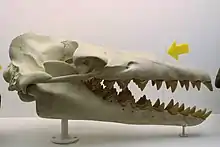Basilosauridae
Basilosauridae is a paraphyletic family of extinct cetaceans. They lived during the middle to the early late Eocene and are known from all continents, including Antarctica.[1][2] They were probably the first fully aquatic cetaceans.[3][4]
| Basilosauridae | |
|---|---|
 | |
| Skull of the genus Saghacetus. | |
| Scientific classification | |
| Kingdom: | Animalia |
| Phylum: | Chordata |
| Class: | Mammalia |
| Order: | Artiodactyla |
| Infraorder: | Cetacea |
| Family: | †Basilosauridae Cope 1868[1] |
| Genera | |
|
See text | |
Characteristics

.jpg.webp)
.jpg.webp)
Basilosaurids ranged in size from 4 to 16 m (13 to 52 ft) and were fairly similar to modern cetaceans in overall body form and function.[5] Some genera tend to show signs of convergent evolution with mosasaurs by having long serpentine body shape, which suggests that this body plan seems to have been rather successful.[6] Basilosaurid forelimbs have broad and fan-shaped scapulae attached to a humerus, radius, and ulna which are flattened into a plane to which the elbow joint was restricted, effectively making pronation and supination impossible. Because of a shortage of forelimb fossils from other arachaocetes, it is not known if this arrangement is unique to basilosaurids, as some of the characteristics are also seen in Georgiacetus.[3]
As archaeocetes, Basilosaurids lacked the telescoping skull of present whales. Their jaws were powerful,[7] with a dentition easily distinguishable from that of other archaeocetes: they lack upper third molars and the upper molars lack protocones, trigon basins, and lingual third roots. The cheek teeth have well-developed accessory denticles.
Unlike modern whales, basilosaurids possessed small hindlimbs with well defined femur, lower leg and feet. They were, however, very small and did not articulate with the vertebral column, which also lack true sacral vertebrae.[3] While they were unable to support body weight on land, they might assissted as claspers during copulation.[8] Analysis of tail vertebrate from Basilosaurus and Dorudon indicate they possessed small flukes.[9]
Taxonomy
Basilosaurinae was proposed as a subfamily containing two genera: Basilosaurus and Basiloterus.[10] They were characterized by elongated distal thoracic vertebrae, lumbar, and proximal sacrococcygeal. All known members of the subfamily are larger than their relatives of the Dorudontinae subfamily except Cynthiacetus.[11] It was declared an invalid subgroup of Basilosauridae by Uhen 2013.[10]
Systematics
- Family Basilosauridae
- Subfamily Basilosaurinae
- Genus Basilosaurus
- Genus Basiloterus
- Genus Basilotritus
- Genus Eocetus
- Genus Platyosphys
- Subfamily Dorudontinae
- Genus Ancalecetus
- Genus Chrysocetus
- Genus Cynthiacetus
- Genus Dorudon
- Genus Masracetus
- Genus Ocucajea
- Genus Saghacetus
- Genus Stromerius
- Genus Supayacetus
- Genus Zygorhiza
- Subfamily Basilosaurinae
Notes
- Basilosauridae in the Paleobiology Database
- Fostowicz-Frelik 2003
- Uhen 2002
- Buono M, Fordyce R.E., Marx F.G., Fernández M.S. & Reguero M. (2019). "Eocene Antarctica: a window into the earliest history of modern whales". Advances in Polar Science 30(3): p. 293-302. doi: 10.13679/j.advps.2019.0005
- Uhen M. (2004). "Form, Function, and Anatomy of Dorudon Atrox (Mammalia, Cetacea): An Archaeocete from the Middle to Late Eocene of Egypt". Papers on Paleontology 34: p. 1-222
- Oceans of Kansas: a Natural History of the Western Interior Sea. Indiana University Press. ISBN 9780253345479.
- Snively E, Fahlke J.M. & Welsh R.C. (2015). "Bone-Breaking Bite Force of Basilosaurus isis (Mammalia, Cetacea) from the Late Eocene of Egypt Estimated by Finite Element Analysis". PLOS ONE 10(2): e0118380
- Gingerich P.D., Smith B.H., Simons E.L. (1990). "Hind limbs of eocene basilosaurus: evidence of feet in whales". Science 249(4965): p. 154–157. doi:10.1126/science.249.4965.154
- Philip D. Gingerich, Mohammed Sameh M. Antar und Iyad S. Zalmot: "Aegicetus gehennae, a new late Eocene protocetid (Cetacea, Archaeoceti) from Wadi Al Hitan, Egypt, and the transition to tail-powered swimming in whales". PLoS ONE 14(12): e0225391 doi:10.1371/journal.pone.0225391
- Basilosauridae in the Paleobiology Database. Retrieved July 2013.
- Uhen 2008
References
- Cope, Edward Drinker (1868). "An addition to the vertebrate fauna of the Miocene period, with a synopsis of the extinct Cetacea of the United States". Proceedings of the Academy of Natural Sciences of Philadelphia. 19 (4): 138–57. JSTOR 4059641. OCLC 4909181381.
- Fostowicz-Frelik, Łucja (2003). "An enigmatic whale tooth from the Upper Eocene of Seymour Island, Antarctica" (PDF). Polish Polar Research. 24 (1): 13–28. doi:10.1002/jmor.20075. PMID 22965565. Retrieved September 2013. Check date values in:
|access-date=(help) - Gingerich, Philip D (2007). "Stromerius nidensis, new archaeocete (Mammalia, Cetacea) from the Upper Eocene Qasr El-Sagha Formation, Fayum, Egypt" (PDF). Contributions from the Museum of Paleontology. 31 (13): 363–78. OCLC 214233870. Retrieved February 2013. Check date values in:
|access-date=(help) - Uhen, Mark D (2002). "Basilosaurids". In Perrin, William R; Wiirsig, Bernd; Thewissen, J G M (eds.). Encyclopedia of Marine Mammals. Academic Press. pp. 78–81. ISBN 978-0-12-551340-1.